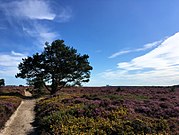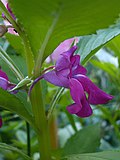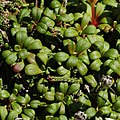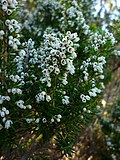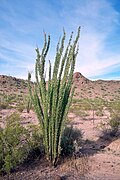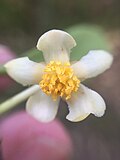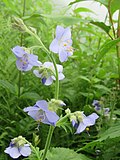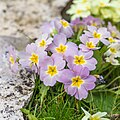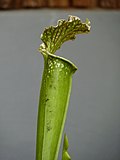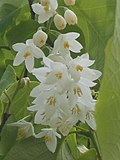List of basal asterid families
| Flowering plant families (APG IV) | |||||
|---|---|---|---|---|---|
|
|
|||||
| Early-diverging flowering plants | |||||
| Monocots: Alismatids • Commelinids • Lilioids | |||||
|
|
|||||
Eudicots
|
Ericales and Cornales, two orders of flowering plants, are often called the basal asterids.[1][2][3][a][b] Like most asterids, these species tend to have petals that are fused with each other and with the bases of the stamens, and just one integument (covering) around the embryo sac.[3]
The basal asterids include crops such as blueberries, cranberries, tea and Brazil nuts.[6] Kiwifruit was named for its resemblance to the brown body of the kiwi, a national symbol of New Zealand.[7] Dogwoods (Cornus) are often grown for their showy bracts.[8] Black or white ebony wood is commonly used for musical instruments and carpentry.[9] Many Hydrangea species are popular garden ornamentals.[10]
Glossary[edit]
From the glossary of botanical terms:
- annual: a plant species that completes its life cycle within a single year or growing season
- basal: attached close to the base (of a plant or an evolutionary tree diagram)
- deciduous: shedding or falling seasonally, as with bark, leaves, or petals
- herbaceous: not woody; usually green and soft in texture
- mangrove: any shrub or small tree that grows in brackish or salt water
- perennial: not an annual or biennial
- succulent (adjective): juicy or fleshy
- woody: hard and lignified; not herbaceous[11]
The APG IV system is the fourth in a series of plant taxonomies from the Angiosperm Phylogeny Group.[1]
There are a few visible traits that can be linked to many of the families. Most Ericales species tend to have woody stems or branches, seed capsules, cellular endosperm and ladder-like vessel perforations.[12][13] Species in Cornales tend to have the same perforations, as well as anthers attached at their base, ring-like nectaries, and cymes, which are inflorescences with lateral stalks that terminate in a flower or another branch.[14]
Families[edit]
| Family and a common name[15][c] | Type genus and etymology[d] | Total genera; global distribution | Description and uses | Order[15] | Type genus images |
|---|---|---|---|---|---|
| Actinidiaceae (kiwifruit family) | Actinidia, from Greek for "radiating out from the center"[17][18][19] | 3 genera, mostly in eastern and southern Asia and the tropical Americas[20][21] | Shrubs, trees and woody vines[22][23] | Ericales[23] | |
| Balsaminaceae (balsam family) | Impatiens. Balsamina, an earlier synonym, is from a Latin plant name.[24][25][26] | 2 genera, scattered worldwide[27][28] | Perennials and annuals, almost always herbaceous, with succulent stems. Several species are cultivated as ornamentals. Impatiens glandulifera has become invasive in Europe and North America.[22][25] | Ericales[25] | |
| Clethraceae (lily-of-the-valley-tree family) | Clethra, from a Greek plant name[29][30][31] | 2 genera, mostly in the Americas and southeastern Asia[32][33] | Evergreen and deciduous trees and shrubs.[22][34] Clethra alnifolia is cultivated for its fragrant flowers.[32] | Ericales[34] | |
| Cornaceae (dogwood family) | Cornus, from a Latin plant name[35][36][37] | 2 genera, scattered worldwide[8][38] | Evergreen and deciduous shrubs, trees and vines, along with rhizomatous herbaceous perennials. The fruits of some species are used in jams or alcoholic drinks. The trees are often grown as ornamentals.[8][39] | Cornales[8] | |
| Curtisiaceae (assegai family) | Curtisia, for William Curtis (1746–1799)[40] | 1 genus, in South Africa and Zimbabwe[41][42] | Evergreen trees with stalked leaves. The wood is harvested for furniture-making.[43] | Cornales[43] | |
| Cyrillaceae (leatherwood family) | Cyrilla, for Domenico Cirillo (1739–1799)[44][45] | 2 genera, mostly in the southeastern US; Cyrilla extends into South America.[46][47] | Usually evergreen trees and shrubs.[22][48] | Ericales[48] | |
| Diapensiaceae (pincushion-plant family) | Diapensia, from a Greek plant name[49][50] | 6 genera, mostly in eastern Asia and in the US Appalachian Mountains.[51][52] | Low-growing evergreen herbaceous perennials, sometimes partly woody, often forming ground cover.[53] | Ericales[53] | |
| Ebenaceae (persimmon family) | Diospyros. Ebenus, an earlier synonym, is from a Greek plant name.[9][54] | 3 genera, mostly in tropical and subtropical lowlands[55][56] | Mostly evergreen trees and shrubs with clear sap and frequently black hardwood. Diospyros kaki and other fruit species called persimmons are widely grown.[9][57] | Ericales[9] | |
| Ericaceae (heather family) | Erica, from Greek and Latin plant names[58][59][60] | 121 genera, found almost worldwide, mostly in temperate zones and the subtropics[61][62] | Deciduous and evergreen trees, vines, shrubs and herbaceous perennials, growing in soil, on flooded land, on rock and on other plants. The most important commercial crops are in Vaccinium, including blueberries and cranberries. Popular garden plants include Rhododendron.[39][61] | Ericales[61] | |
| Fouquieriaceae (ocotillo family) | Fouquieria, for Pierre Fouquier (1776–1850), a physician[63] | 1 genus, in Mexico, Texas and Arizona[64][65] | Spiny shrubs and trees with almost erect, outward-leaning branches. Fouquieria splendens (ocotillo) is a popular North American arid-garden plant.[22][63] | Ericales[63] | |
| Grubbiaceae (koolhout family) | Grubbia, for Michael Grubb (1728–1808), a Swedish botanist and mineralogist[66] | 1 genus, South Africa[67][68] | Evergreen and deciduous shrubs with opposite leaves.[69] | Cornales[69] | |
| Hydrangeaceae (hortensia family) | Hydrangea, from Greek for "water jar", which the fruit resembles[70][71][72] | 9 genera, with centers of diversity in temperate North America, mountainous Europe and East Asia[10][73] | Deciduous and evergreen shrubs, small trees, woody vines and herbaceous plants. Hydrangea macrophylla has been cultivated in Japan for millennia.[10][22] | Cornales[10] | |
| Hydrostachyaceae (waterspike family) | Hydrostachys, from Greek for "water spike"[74] | 1 genus, in Madagascar and tropical and southern Africa[75][76] | Submerged scaly herbaceous perennials with a disc-shaped stem that clings to rocks in rapids.[39][74] | Cornales[74] | |
| Lecythidaceae (cannonball-tree family) | Lecythis, from Greek for "oil pot", which the fruit resembles[77][78] | 24 genera, scattered throughout the tropics.[77][79] | Shrubs and trees, sometimes up to 55 m (180 ft) high. Of various edible seeds and nuts, the most important commercially is the Brazil nut. Several species provide timber.[39][77] | Ericales[77] | |
| Loasaceae (blazingstar family) | Loasa, probably from a South American plant name[80][81] | 21 genera, mostly in the Americas[82][83] | Shrubs, woody vines, small trees and herbaceous plants.[22][80] Several species are used in traditional medicine in the Andes.[84] | Cornales[80] | |
| Marcgraviaceae (shingle-vine family) | Marcgravia, for Georg Marcgrave (1610–1644)[85][86] | 7 genera, in the tropics of the Americas[87][88] | Shrubs, vines and occasionally small trees that grow in soil and on other plants.[22][89] | Ericales[89] | |
| Mitrastemonaceae (nippledaisy family) | Mitrastemon, from Greek for "miter stamen"[90] | 1 genus, in Central America, Colombia and tropical Asia[90][91] | Mushroom-like parasites without chlorophyll that feed on tree roots.[22][90] | Ericales[90] | |
| Nyssaceae (tupelo-tree family) | Nyssa, for Nysa, a water nymph of Greek myth[92][93][94] | 5 genera, southern and southeastern Asia, and North and Central America[95][96] | Deciduous and evergreen trees. Nyssa ogeche (ogeechee lime) is sometimes used in preserves and jams, and tupelo is harvested for wood.[95] | Cornales[95] | |
| Pentaphylacaceae (saintedwood family) | Pentaphylax, from Greek for "five guardians"[97][98][99] | 13 genera, mostly spread across the American and Asian tropics, with some in temperate zones.[98][100] | Evergreen shrubs and trees with stalked leaves. Anneslea fragrans produces wood with attractive grain markings.[22][98] | Ericales[98] | |
| Polemoniaceae (Jacob's-ladder family) | Polemonium, from a Greek plant name[101][102][103] | 27 genera, mostly in western North America[104][105] | Mostly herbaceous annuals and perennials, with some small trees and shrubs. Some species have been used as a soap substitute by Native Americans. Cantua buxifolia is the national flower of Peru.[22][106] | Ericales[106] | |
| Primulaceae (primrose family) | Primula, from a Medieval Latin plant name[107][108][109] | 57 genera, in northern temperate and arctic zones, mainly[110][111] | Trees, shrubs, mangroves, vines and herbaceous plants. Many genera are cultivated as ornamentals, including Androsace (rock jasmine) and various plants called primroses.[57][112] | Ericales[112] | |
| Roridulaceae (flycatcher-bush family) | Roridula, from Latin "little" and Greek "dewy"[113] | 1 genus, in southwest South Africa[114][115] | Evergreen shrubs that trap insects.[113] | Ericales[113] | |
| Sapotaceae (sapodilla family) | Manilkara. Sapota, an earlier synonym, is from Nahuatl for "soft fruit".[116][117][118] | 62 genera, scattered in the humid tropics worldwide[119][120] | Latex-bearing shrubs, trees and woody vines. Manilkara zapota (sapodilla) and Chrysophyllum cainito (star apple) are widely cultivated fruits.[57][116] | Ericales[116] | |
| Sarraceniaceae (American-pitcherplant family) | Sarracenia, for Michel Sarrazin (1659–1736)[121][122] | 3 genera, in the Americas[123][124] | Carnivorous, usually herbaceous perennials with underground rhizomes. The tubes (modified leaves) attract, trap and digest tiny animals. Some of these plants are grown in bog gardens.[22][121] | Ericales[121] | |
| Sladeniaceae (ribfruit family) | Sladenia, for Edward Bosc Sladen (1827–1890), an army officer[125][126] | 2 genera, in southeastern Asia and eastern Africa[127][128] | Evergreen trees with stalked leaves.[129] | Ericales[129] | |
| Styracaceae (storax family) | Styrax, from Arabic and Greek plant names[130][131][132] | 12 genera, mainly in the Americas and Asia[133][134] | Deciduous and evergreen shrubs and trees. The pharmaceutical resin benzoin is harvested from Styrax.[57][135] | Ericales[135] | |
| Symplocaceae (sweetleaf family) | Symplocos, from Greek for "a combining" (of the stamens)[136] | 1 genus, in parts of eastern Asia, Oceania and the Americas[137][138] | Usually evergreen shrubs and trees.[22][139] The bark or leaves of some species are used in the preparation of dyes in Indonesia.[137] | Ericales[139] | |
| Tetrameristaceae (punah family) | Tetramerista, from Greek for "four parts" (describing only Tetramerista flowers)[140][141] | 3 genera, with Tetramerista in Southeast Asia and the others in Central and South America[140][142] | Shrubs, trees and mangroves with fluted trunks. Tetramerista is harvested for wood, and has edible fruit.[22][140] | Ericales[140] | |
| Theaceae (tea family) | Camellia. Thea, an earlier synonym, is from a Chinese plant name.[143][144][145] | 8 genera, scattered in the northern temperate zones and the tropics[146][147] | Usually evergreen shrubs and trees. Tea (from Camellia sinensis) has been brewed in China for over 2000 years. Camellia, Franklinia, Gordonia and Stewartia are common garden ornamentals.[143][148] | Ericales[143] |
See also[edit]
Notes[edit]
- ^ Since 2019, these two orders have increasingly been identified as a single clade, a group of plants more closely related to each other than to any outside the group.[3]
- ^ The taxonomy (classification) in this list follows Plants of the World (2017)[4] and the fourth Angiosperm Phylogeny Group system.[1] Total counts of genera for each family come from Plants of the World Online.[5] (See the POWO license.) Extinct taxa are not included.
- ^ Each family's formal name ends in the Latin suffix -aceae and is derived from the name of a genus that is or once was part of the family.[16]
- ^ Some plants were named for naturalists (unless otherwise noted).
Citations[edit]
- ^ a b c Angiosperm Phylogeny Group 2016.
- ^ Christenhusz, Fay & Chase 2017, pp. 471, 479.
- ^ a b c Stevens 2023, Asterids.
- ^ Christenhusz, Fay & Chase 2017.
- ^ POWO.
- ^ Christenhusz, Fay & Chase 2017, pp. 485–487, 496–497, 506–510.
- ^ Christenhusz, Fay & Chase 2017, p. 504.
- ^ a b c d Christenhusz, Fay & Chase 2017, pp. 477–479.
- ^ a b c d Christenhusz, Fay & Chase 2017, pp. 491–492.
- ^ a b c d Christenhusz, Fay & Chase 2017, pp. 473–474.
- ^ Christenhusz, Fay & Chase 2017, pp. 638–670.
- ^ Kubitzki 2004, p. 9.
- ^ Stevens 2023, Ericales.
- ^ Stevens 2023, Cornales.
- ^ a b Christenhusz, Fay & Chase 2017, pp. 471–510.
- ^ ICN, art. 18.
- ^ Stearn 2002, p. 31.
- ^ Coombes 2012, p. 31.
- ^ IPNI, Actinidiaceae, Type.
- ^ Dressler & Bayer 2004, pp. 16–18.
- ^ POWO, Actinidiaceae.
- ^ a b c d e f g h i j k l m n POWO, Neotropikey.
- ^ a b Christenhusz, Fay & Chase 2017, pp. 503–504.
- ^ POWO, Balsamina.
- ^ a b c Christenhusz, Fay & Chase 2017, pp. 479–480.
- ^ IPNI, Balsaminaceae, Type.
- ^ Fischer 2004, p. 24.
- ^ POWO, Balsaminaceae.
- ^ Stearn 2002, p. 96.
- ^ Coombes 2012, p. 99.
- ^ IPNI, Clethraceae, Type.
- ^ a b Schneider & Bayer 2004, p. 72.
- ^ POWO, Clethraceae.
- ^ a b Christenhusz, Fay & Chase 2017, pp. 504–505.
- ^ Stearn 2002, p. 104.
- ^ Coombes 2012, p. 104.
- ^ IPNI, Cornaceae, Type.
- ^ POWO, Cornaceae.
- ^ a b c d POWO, Flora of Tropical East Africa.
- ^ Burkhardt 2018, p. C-76.
- ^ Kubitzki 2004, p. 112.
- ^ POWO, Curtisiaceae.
- ^ a b Christenhusz, Fay & Chase 2017, pp. 476–477.
- ^ Stearn 2002, p. 111.
- ^ IPNI, Cyrillaceae, Type.
- ^ Kubitzki 2004, p. 115.
- ^ POWO, Cyrillaceae.
- ^ a b Christenhusz, Fay & Chase 2017, pp. 505–506.
- ^ Stearn 2002, p. 118.
- ^ IPNI, Diapensiaceae, Type.
- ^ Scott 2004, p. 119.
- ^ POWO, Diapensiaceae.
- ^ a b Christenhusz, Fay & Chase 2017, pp. 498–499.
- ^ POWO, Ebenus.
- ^ Wallnöfer 2004, p. 128.
- ^ POWO, Ebenaceae.
- ^ a b c d POWO, Flora of West Tropical Africa.
- ^ Stearn 2002, p. 133.
- ^ Coombes 2012, p. 134.
- ^ IPNI, Ericaceae, Type.
- ^ a b c Christenhusz, Fay & Chase 2017, pp. 506–510.
- ^ POWO, Ericaceae.
- ^ a b c Christenhusz, Fay & Chase 2017, pp. 482–484.
- ^ Kubitzki 2004, p. 197.
- ^ POWO, Fouquieriaceae.
- ^ Quattrocchi 2000, p. 1122.
- ^ Kubitzki 2004, p. 201.
- ^ POWO, Grubbiaceae.
- ^ a b Christenhusz, Fay & Chase 2017, p. 477.
- ^ Stearn 2002, p. 170.
- ^ Coombes 2012, p. 171.
- ^ IPNI, Hydrangeaceae, Type.
- ^ POWO, Hydrangeaceae.
- ^ a b c Christenhusz, Fay & Chase 2017, pp. 472–473.
- ^ Erbar & Leins 2004, p. 219.
- ^ POWO, Hydrostachyaceae.
- ^ a b c d Christenhusz, Fay & Chase 2017, pp. 485–487.
- ^ IPNI, Lecythidaceae, Type.
- ^ POWO, Lecythidaceae.
- ^ a b c Christenhusz, Fay & Chase 2017, pp. 474–476.
- ^ IPNI, Loasaceae, Type.
- ^ Weigend 2004, p. 244.
- ^ POWO, Loasaceae.
- ^ Weigend 2004, p. 246.
- ^ Quattrocchi 2019, p. 1615.
- ^ IPNI, Marcgraviaceae, Type.
- ^ Dressler 2004, p. 262.
- ^ POWO, Marcgraviaceae.
- ^ a b Christenhusz, Fay & Chase 2017, pp. 480–481.
- ^ a b c d Christenhusz, Fay & Chase 2017, p. 510.
- ^ POWO, Mitrastemonaceae.
- ^ Stearn 2002, p. 220.
- ^ Coombes 2012, p. 215.
- ^ IPNI, Nyssaceae, Type.
- ^ a b c Christenhusz, Fay & Chase 2017, pp. 471–472.
- ^ POWO, Nyssaceae.
- ^ Quattrocchi 2019, p. 2002.
- ^ a b c d Christenhusz, Fay & Chase 2017, pp. 488–489.
- ^ IPNI, Pentaphylacaceae, Type.
- ^ POWO, Pentaphylacaceae.
- ^ Stearn 2002, p. 245.
- ^ Coombes 2012, p. 239.
- ^ IPNI, Polemoniaceae, Type.
- ^ Wilken 2004, p. 305.
- ^ POWO, Polemoniaceae.
- ^ a b Christenhusz, Fay & Chase 2017, pp. 484–485.
- ^ Stearn 2002, p. 248.
- ^ Coombes 2012, p. 242.
- ^ IPNI, Primulaceae, Type.
- ^ Anderberg 2004, p. 315.
- ^ POWO, Primulaceae.
- ^ a b Christenhusz, Fay & Chase 2017, pp. 492–494.
- ^ a b c Christenhusz, Fay & Chase 2017, p. 502.
- ^ Conran 2004, p. 341.
- ^ POWO, Roridulaceae.
- ^ a b c Christenhusz, Fay & Chase 2017, pp. 489–491.
- ^ POWO, Sapota.
- ^ IPNI, Sapotaceae, Type.
- ^ Pennington 2004, p. 398.
- ^ POWO, Sapotaceae.
- ^ a b c Christenhusz, Fay & Chase 2017, pp. 500–501.
- ^ IPNI, Sarraceniaceae, Type.
- ^ Kubitzki 2004, p. 424.
- ^ POWO, Sarraceniaceae.
- ^ Burkhardt 2018, p. S-71.
- ^ USDA, Sladeniaceae, Type.
- ^ Stevens & Weitzman 2004, p. 432.
- ^ POWO, Sladeniaceae.
- ^ a b Christenhusz, Fay & Chase 2017, p. 487.
- ^ Stearn 2002, p. 287.
- ^ Coombes 2012, p. 282.
- ^ IPNI, Styracaceae, Type.
- ^ Fritsch 2004, pp. 438–439.
- ^ POWO, Styracaceae.
- ^ a b Christenhusz, Fay & Chase 2017, pp. 499–500.
- ^ Stearn 2002, p. 289.
- ^ a b Nooteboom 2004, p. 447.
- ^ POWO, Symplocaceae.
- ^ a b Christenhusz, Fay & Chase 2017, pp. 497–498.
- ^ a b c d Christenhusz, Fay & Chase 2017, pp. 481–482.
- ^ IPNI, Tetrameristaceae, Type.
- ^ POWO, Tetrameristaceae.
- ^ a b c Christenhusz, Fay & Chase 2017, pp. 496–497.
- ^ POWO, Thea.
- ^ IPNI, Theaceae, Type.
- ^ Stevens, Dressler & Weitzman 2004, pp. 466–467.
- ^ POWO, Theaceae.
- ^ POWO, Flora of Zambesiaca.
References[edit]
- Anderberg, A. A. (2004). "Primulaceae". In Kubitzki, K. (ed.). Celastrales, Oxalidales, Rosales, Cornales, Ericales. Vol. VI. Berlin: Springer Science+Business Media. p. 315. doi:10.1007/978-3-662-07257-8. ISBN 978-3-662-07257-8. S2CID 12809916.
- Angiosperm Phylogeny Group (2016). "An update of the Angiosperm Phylogeny Group classification for the orders and families of flowering plants: APG IV". Botanical Journal of the Linnean Society. 181 (1): 1–20. doi:10.1111/boj.12385.
- Burkhardt, Lotte (2018). Verzeichnis eponymischer Pflanzennamen – Erweiterte Edition [Index of Eponymic Plant Names – Extended Edition] (pdf) (in German). Berlin: Botanic Garden and Botanical Museum, Freie Universität Berlin. doi:10.3372/epolist2018. ISBN 978-3-946292-26-5. S2CID 187926901. Retrieved January 1, 2021. See the licence.
- Christenhusz, Maarten; Fay, Michael Francis; Chase, Mark Wayne (2017). Plants of the World: An Illustrated Encyclopedia of Vascular Plants. Chicago, Illinois: Kew Publishing and The University of Chicago Press. ISBN 978-0-226-52292-0.
- Conran, J. G. (2004). "Roridulaceae". In Kubitzki, K. (ed.). Celastrales, Oxalidales, Rosales, Cornales, Ericales. Vol. VI. Berlin: Springer Science+Business Media. p. 341. doi:10.1007/978-3-662-07257-8. ISBN 978-3-662-07257-8. S2CID 12809916.
- Coombes, Allen (2012). The A to Z of Plant Names: A Quick Reference Guide to 4000 Garden Plants. Portland, Oregon: Timber Press. ISBN 978-1-60469-196-2.
- Dressler, S. (2004). "Marcgraviaceae". In Kubitzki, K. (ed.). Celastrales, Oxalidales, Rosales, Cornales, Ericales. Vol. VI. Berlin: Springer Science+Business Media. p. 262. doi:10.1007/978-3-662-07257-8. ISBN 978-3-662-07257-8. S2CID 12809916.
- Dressler, S.; Bayer, C. (2004). "Actinidiaceae". In Kubitzki, K. (ed.). Celastrales, Oxalidales, Rosales, Cornales, Ericales. Vol. VI. Berlin: Springer Science+Business Media. pp. 16–18}. doi:10.1007/978-3-662-07257-8. ISBN 978-3-662-07257-8. S2CID 12809916.
- Erbar, C.; Leins, P. (2004). "Hydrostachyaceae". In Kubitzki, K. (ed.). Celastrales, Oxalidales, Rosales, Cornales, Ericales. Vol. VI. Berlin: Springer Science+Business Media. p. 219. doi:10.1007/978-3-662-07257-8. ISBN 978-3-662-07257-8. S2CID 12809916.
- Fischer, E. (2004). "Balsaminaceae". In Kubitzki, K. (ed.). Celastrales, Oxalidales, Rosales, Cornales, Ericales. Vol. VI. Berlin: Springer Science+Business Media. p. 24. doi:10.1007/978-3-662-07257-8. ISBN 978-3-662-07257-8. S2CID 12809916.
- Fritsch, P. W. (2004). "Styracaceae". In Kubitzki, K. (ed.). Celastrales, Oxalidales, Rosales, Cornales, Ericales. Vol. VI. Berlin: Springer Science+Business Media. pp. 438–439. doi:10.1007/978-3-662-07257-8. ISBN 978-3-662-07257-8. S2CID 12809916.
- IPNI (2022). "International Plant Names Index". London, Boston and Canberra: Royal Botanic Gardens, Kew; Harvard University Herbaria & Libraries; and the Australian National Botanic Gardens. Retrieved December 20, 2022.
- Kubitzki, K. (2004). "Introduction to Families Treated in This Volume, Curtisiaceae, Cyrillaceae, Fouquieriaceae, Grubbiaceae, Sarraceniaceae". In Kubitzki, K. (ed.). Celastrales, Oxalidales, Rosales, Cornales, Ericales. Vol. VI. Berlin: Springer Science+Business Media. pp. 9, 112, 115, 197, 201, 424. doi:10.1007/978-3-662-07257-8. ISBN 978-3-662-07257-8. S2CID 12809916.
- Nooteboom, H. P. (2004). "Symplocaceae". In Kubitzki, K. (ed.). Celastrales, Oxalidales, Rosales, Cornales, Ericales. Vol. VI. Berlin: Springer Science+Business Media. p. 447. doi:10.1007/978-3-662-07257-8. ISBN 978-3-662-07257-8. S2CID 12809916.
- Pennington, T. D. (2004). "Sapotaceae". In Kubitzki, K. (ed.). Celastrales, Oxalidales, Rosales, Cornales, Ericales. Vol. VI. Berlin: Springer Science+Business Media. p. 398. doi:10.1007/978-3-662-07257-8. ISBN 978-3-662-07257-8. S2CID 12809916.
- POWO (2019). "Plants of the World Online". London: Royal Botanic Gardens, Kew. Archived from the original on March 22, 2017. Retrieved January 1, 2023. See their terms-of-use license.
- Quattrocchi, Umberto (2000). CRC World Dictionary of Plant Names, Volume II, D–L. Boca Raton, Florida: CRC Press. ISBN 978-0-8493-2676-9.
- Quattrocchi, Umberto (2019) [2000]. CRC World Dictionary of Plant Names, Volume III, M–Q. Boca Raton, Florida: CRC Press. ISBN 978-0-367-44751-9.
- Schneider, J. V.; Bayer, C. (2004). "Clethraceae". In Kubitzki, K. (ed.). Celastrales, Oxalidales, Rosales, Cornales, Ericales. Vol. VI. Berlin: Springer Science+Business Media. p. 72. doi:10.1007/978-3-662-07257-8. ISBN 978-3-662-07257-8. S2CID 12809916.
- Scott, P. J. (2004). "Diapensiaceae". In Kubitzki, K. (ed.). Celastrales, Oxalidales, Rosales, Cornales, Ericales. Vol. VI. Berlin: Springer Science+Business Media. p. 119. doi:10.1007/978-3-662-07257-8. ISBN 978-3-662-07257-8. S2CID 12809916.
- Stearn, William (2002). Stearn's Dictionary of Plant Names for Gardeners. London: Cassell. ISBN 978-0-304-36469-5.
- Stevens, P.F. (2023) [2001]. "Angiosperm Phylogeny Website". Missouri Botanical Garden. Retrieved January 2, 2023.
- Stevens, P. F.; Weitzman, A. L. (2004). "Sladeniaceae". In Kubitzki, K. (ed.). Celastrales, Oxalidales, Rosales, Cornales, Ericales. Vol. VI. Berlin: Springer Science+Business Media. p. 432. doi:10.1007/978-3-662-07257-8. ISBN 978-3-662-07257-8. S2CID 12809916.
- Stevens, P. F.; Dressler, S.; Weitzman, A. L. (2004). "Theaceae". In Kubitzki, K. (ed.). Celastrales, Oxalidales, Rosales, Cornales, Ericales. Vol. VI. Berlin: Springer Science+Business Media. pp. 466–467. doi:10.1007/978-3-662-07257-8. ISBN 978-3-662-07257-8. S2CID 12809916.
- Turland, N. J.; et al. (eds.). International Code of Nomenclature for algae, fungi, and plants (Shenzhen Code) adopted by the Nineteenth International Botanical Congress Shenzhen, China, July 2017 (electronic ed.). Glashütten: International Association for Plant Taxonomy. Retrieved February 25, 2022.
- "USDA, Agricultural Research Service, National Plant Germplasm System". Germplasm Resources Information Network (GRIN Taxonomy). Beltsville, Maryland: National Germplasm Resources Laboratory. 2022. Retrieved December 20, 2022.
- Wallnöfer, B. (2004). "Ebenaceae". In Kubitzki, K. (ed.). Celastrales, Oxalidales, Rosales, Cornales, Ericales. Vol. VI. Berlin: Springer Science+Business Media. p. 128. doi:10.1007/978-3-662-07257-8. ISBN 978-3-662-07257-8. S2CID 12809916.
- Weigend, M. (2004). "Loasaceae". In Kubitzki, K. (ed.). Celastrales, Oxalidales, Rosales, Cornales, Ericales. Vol. VI. Berlin: Springer Science+Business Media. pp. 244, 246. doi:10.1007/978-3-662-07257-8. ISBN 978-3-662-07257-8. S2CID 12809916.
- Wilken, D. H. (2004). "Polemoniaceae". In Kubitzki, K. (ed.). Celastrales, Oxalidales, Rosales, Cornales, Ericales. Vol. VI. Berlin: Springer Science+Business Media. p. 305. doi:10.1007/978-3-662-07257-8. ISBN 978-3-662-07257-8. S2CID 12809916.

